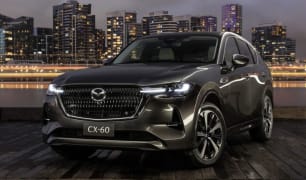The launch drive was limited to the 300d variant, though I did get a chance to sample the version with air suspension, as well as the model with the standard steel suspension.
Now, before we get too nerdy, this is an important element for a luxury SUV. Ride comfort is arguably as vital as effortless power. And, sadly for the GLE, neither model sets any benchmarks for suspension control and comfort.
The steel-sprung model doesn't have adaptive suspension at all, meaning that it can be bouncy, wobbly, unsettled and stiff all at the same time. The country road I sampled it on showed that the standard suspension offered up a quite nervous experience, never feeling as settled as a luxury SUV really ought to.
The air suspension version is definitely better, but still not as good as a BMW X5, Audi Q7 or VW Touareg. It lacks the body control and comfort that a true luxury SUV ought to offer.
Now, that might matter to you, or it might not. You might think the look of the car - with 20s, 21s or 22s filling the guards - is more important than how it deals with lumps and bumps. But it's our job to tell you how the land lies, and the GLE simply can't match the better SUVs in this segment as a driver's tool.
There is another level of suspension which the CarsGuide team (myself included) hasn't yet had the chance to sample - the E-Active Body Control system, which includes curve-tilting so it can make the car feel level through corners, and a system that'll scan the road ahead to predict bumps and lumps and prime the suspension to deal with it. That system is $13,000... and, while I haven't sampled it yet, it's my hope that it makes all the difference to the GLE.
So, what about the other driving elements? Well the steering is light and accurate, and decently responsive at low speeds or highway pace, and you're never left guessing as to what'll happen.
The engine, too, is decent - a 2.0-litre with 180kW and 500Nm is nothing to be sneezed at - but in a vehicle this large, with a kerb weight of 2165kg, and with a nine-speed automatic taking care of forward progress, it can be a busy engine.
That's because the transmission will shuffle between ratios when you encounter a hill as it doesn't quite have the grunt to simply stick in a gear and tug you along. It's not that big of a deal, and the transmission is smooth enough and pretty hard to catch out, but it is a little less effortless than a six-cylinder would no doubt be.
All in all, I was left wanting more from the drive experience. Maybe the higher-grade models with the highest-grade suspension will prove a better flag waver for the new-generation GLE.

